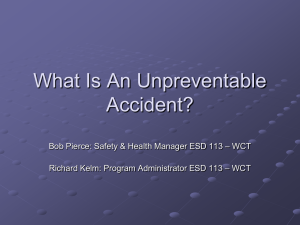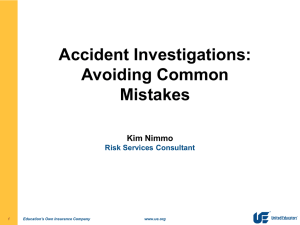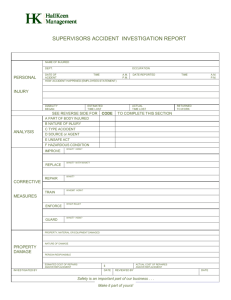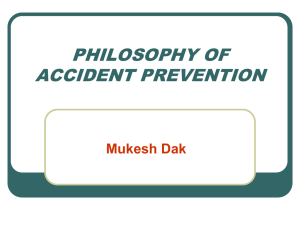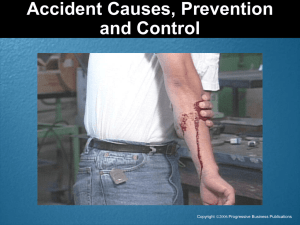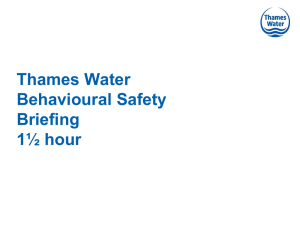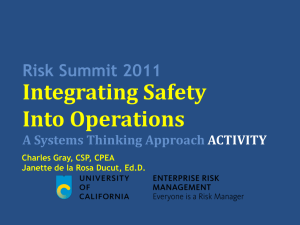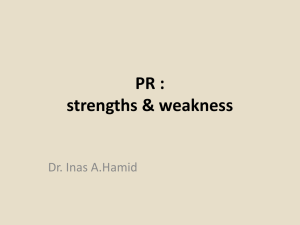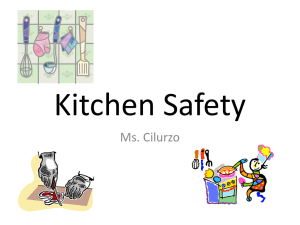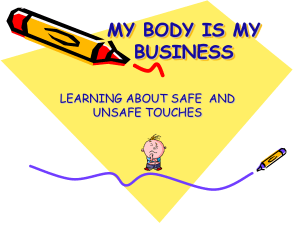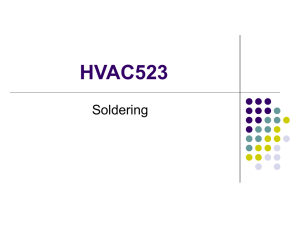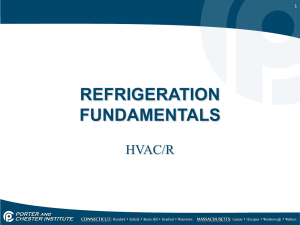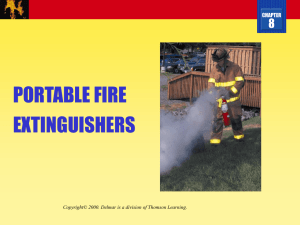Safety in Electronics
advertisement
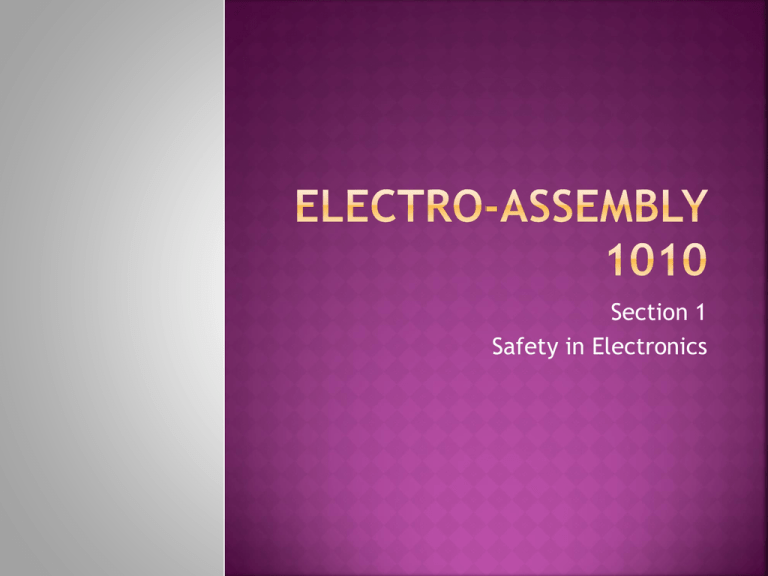
Section 1 Safety in Electronics 2013 Fertilizer plant explosion near Waco, Texas http://www.youtube.com/watch?v=Ba8jTkRWiwI 2013 Rana Plaza factory building collapse near Dhaka, Bangladesh http://www.youtube.com/watch?v=poQoWBSgiEA 2011 Fukushima Daiichi nuclear disaster in Japan http://www.youtube.com/watch?v=8c2GN63HUhM In general, an accident is an unplanned and unexpected event that interferes with the activity a person is engaged in. An accident may lead to an injury to the person directly involved; it may also lead to the injury of others. When an accident occurs, you can never be sure of the outcome. The result of an accident can range from a minor irritation to a major injury and even death. Accidents a cause. For do not just happen. They all have example, a person can easily cause an accident by repairing electrical equipment while it is still hooked up to power. The question to ask of a person doing this type of activity is not whether an accident will happen, but when the accident will occur, because sooner or later the worker will touch a live wire (if the worker continues doing this type of activity). It would not be truthful to say, ”Look, an accident happened to that worker.” It would be more appropriate to say, “Look, that worker just caused an accident.” http://www.youtube.com/watch?v=aXRe0HY AUeU http://www.youtube.com/watch?v=DX1iplQQ JTo http://www.youtube.com/watch?v=FZrkaZxuYU An unsafe act is anything a worker does that does not follow accepted, normal, or correct procedure or practice. Unsafe acts lead to accidents. An unsafe condition is any hazardous physical condition, which if left uncorrected, can lead to an accident. You must recognize and identify unsafe acts in order to remove them. The better you are at recognizing dangerous acts and conditions, the less accident-prone you will be. Failing to wear safe attire is considered an unsafe act. Without proper clothing, a person soldering an electronics project could receive a severe burn if a drop of molten solder landed on him or her. Distracting, teasing, abusing, or startling someone are all unsafe acts. Distractions prevent people from concentrating on what they are doing and can cause injuries like a burn from touching a hot soldering iron. Operating equipment without warning people in the area (for example, using a soldering iron creates toxic fumes). Operating equipment before checking out its condition (for example, a power tool might have a short circuit) Operating equipment before securing accessories (for example, saw blades or drill bits should be tightly secured) Failing to shut off equipment that is unattended (for example, a soldering iron left plugged in could seriously burn someone or start a fire. Operating equipment in an unsafe environment (for example, using a soldering iron near flammable material. Working with, or near equipment after taking drugs, alcohol or any medication (prescription or nonprescription) that can make you dizzy or sleepy. Working on equipment that is still connected to a power source. Defective equipment make working conditions unsafe. Extension cords with damaged insulation are dangerous, especially in wet conditions. Equipment or cords with exposed live wires are extremely dangerous. Improper ventilation in the work area is unsafe. Fumes from the materials being worked on to remain in the work area making it unsafe (for example, solder and flux fumes). Wet work areas are a hazard. Do not work around or with equipment if the floor is wet. It is easy for you and/or your equipment to slip if the work area is wet. The wet area could also be a dangerous (toxic) substance. Power equipment should never be used outdoors after a rain until the ground has dried. Portable power equipment must be grounded or it be of the double-insulated type. Double-insulated tools have an insulating case so the operator does not touch any parts that could give him or her a shock. To reduce accidents, you must work to remove the causes. Overconfidence can lead to accidents. Have you ever seen a car slide on a slippery ice patch and then, once recovered, take off as if nothing has happened? If the driver of this car did not learn from the experience and continued the unsafe driving (unsafe acts), he or she could cause a serious accident. Accident prevention also means considering and acknowledging your own limitations before attempting a job. For example, you should never attempt to lift an object if you are not strong enough. If you move material from a shelf, but you cannot hold it because it is too heavy, you could easily develop a back, leg, or foot injury. The possibility of injury from shocks or burns always exists when working with electrical equipment. Develop attitudes and habits that maintain safety as a first priority to prevent injuries. Mistakes and carelessness may result in injury to you or someone else. It is therefore important to have some knowledge about first-aid practices. Contact with a live or bare wire/cable or a stoke of lightening can cause electrical current to pass through the body. This can cause severe, potentially fatal injury, depending on the amount of current, its path through the body and the duration of contact. There are two main types of electrical injuries: Shock Burns Electrical injuries can occur anywhere electricity is being used to power appliances or machines. Overhead, high-voltage supply lines can also cause injuries. The following chart lists some of the possible effects of electric shocks received by the passage of various current values. The current values are given in milliamperes (1/1000 A or 0.001 A). These values are very small when you consider the average outlet in the home is fully capable of delivering 15 amperes (15 000 milliamperes). Burns may be severe and deep, especially with higher voltages. With any heat burn the skin is usually destroyed. The burn penetrates into the flesh beneath the area in direct contact with the burn. In the case of an electrical contact burn, the destruction of the flesh fans out into the body. A section of the destroyed tissue is cone-shaped, spreading out from the surface of the burn. As a result, it is very difficult to determine the seriousness of an electrical contact burn simply by examining the surface area. Work areas that involve the use of tools that generate heat, such as soldering irons, should have a fire extinguisher close by. If a fire occurs, always call the fire department first. Alert anyone else working in the area. Do not attempt to put out the fire unless you are absolutely sure you can contain it. Some fires may be easily put out if you respond quickly, while a fire is just beginning to flare up. Become familiar with the fire extinguishers around you. Read the directions on each fire extinguisher before you have to use it; the types of fires it can be used on will be given. Some types of fire extinguishers, such as dry chemical extinguishers and carbon dioxide extinguishers, can be used on flammable liquids without spreading the fire and without fear of electrocution. Water is one of the best fire-fighting agents if it is used on appropriate types of fires. Water can be used to extinguish fires in wood and paper, as long as there are no electrical wires close by. Electricity can conduct back along the water and possibly electrocute the person fighting the fire if electrical wires are involved. Respond immediately after an accident occurs. Emergency response should be made available as quickly as possible. A person's injuries could quickly get worse if emergency treatment is not carried out immediately. If there is a serious injury, is important to call for an ambulance as quickly as possible. If a person has come in contact with high voltage, do not attempt to touch him or her until you are sure the power is off. Touching a person or vehicle or machine still in contact with live wires could get you electrocuted. First-aid supplies should be available wherever work is taking place. Minor cuts and other injuries should be treated to prevent infection. If there is any doubt as to the seriousness of an injury, visit a doctor as soon as possible
